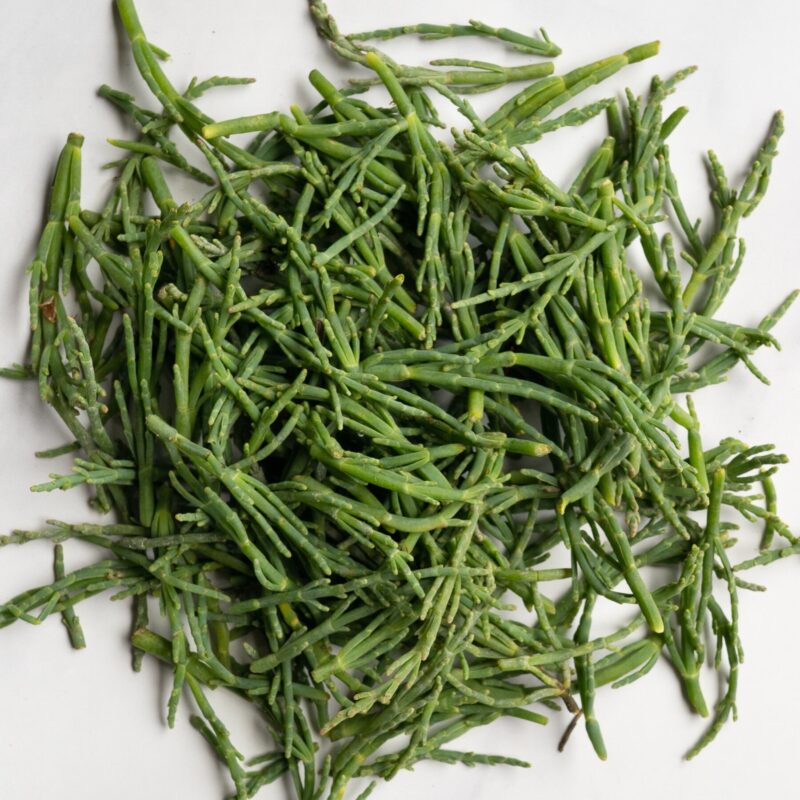No products in the cart.
There are plenty of green foods that are not commonly eaten but are rich in nutrients and offer unique flavors. Some of these are lesser-known vegetables, herbs, and even seaweeds that many people might not be familiar with. Here’s a list of green foods that are packed with health benefits but often fly under the radar:
1. Sea Beans (Samphire)
- What is it?: Sea beans, also known as samphire or sea asparagus, are succulent plants that grow in coastal areas.
- Why it’s unique: They have a slightly salty, briny flavor due to their marine environment. Their crunchy texture and fresh taste make them great additions to salads or seafood dishes.
- How to eat it: Usually served lightly steamed or sautéed, sea beans can be eaten on their own or used as a garnish for fish and other seafood.

2. Moringa
- What is it?: Moringa is a fast-growing tree whose leaves are often dried and ground into powder or eaten fresh.
- Why it’s unique: This superfood is packed with vitamins, minerals, and antioxidants, including Vitamin C, calcium, and protein.
- How to eat it: Moringa can be added to smoothies, teas, or soups. You can also use fresh moringa leaves in salads or cooked like spinach.
3. Stinging Nettle
- What is it?: A wild plant that’s often considered a weed, stinging nettle must be cooked to remove its sting.
- Why it’s unique: It’s rich in vitamins A, C, and K, as well as iron and calcium. It also has anti-inflammatory properties.
- How to eat it: Once cooked, it can be used similarly to spinach, in soups, stews, or even as a base for pesto.
4. Purslane
- What is it?: Purslane is a leafy green that is considered a weed in many regions but is actually edible and nutritious.
- Why it’s unique: It has a slightly sour, tangy flavor and is rich in omega-3 fatty acids, antioxidants, and vitamin E.
- How to eat it: Purslane can be eaten raw in salads, or sautéed with garlic and olive oil. It’s commonly used in Mediterranean and Mexican cuisines.
5. Chayote Greens
- What is it?: Chayote is a type of gourd, and while the fruit is more well-known, its leaves and shoots are edible too.
- Why it’s unique: The greens are tender and have a mild, slightly sweet taste.
- How to eat it: Chayote greens can be steamed, stir-fried, or used in soups and stews, similar to spinach or kale.
6. Fiddlehead Ferns
- What is it?: Fiddlehead ferns are the young, curled fronds of the fern plant.
- Why it’s unique: They have a nutty, grassy flavor with a hint of asparagus. They’re also high in omega-3 fatty acids, fiber, and antioxidants.
- How to eat it: Fiddleheads should be boiled or steamed before eating to remove any bitterness. Once cooked, they can be sautéed with butter and garlic or added to salads and stir-fries.
7. Green Zebra Tomatoes
- What is it?: Green Zebra tomatoes are a unique heirloom variety with green skin and yellow stripes.
- Why it’s unique: They have a tangy, slightly tart flavor, unlike the sweetness of red tomatoes.
- How to eat it: They can be eaten fresh in salads, salsas, or used as a topping for sandwiches and bruschetta. Their bright, acidic flavor pairs well with creamy cheeses.
8. Watercress
- What is it?: Watercress is a leafy green that grows in aquatic environments, often in the wild.
- Why it’s unique: It has a peppery, slightly spicy taste and is packed with vitamins A, C, and K. It’s also rich in antioxidants and known for its health benefits for the immune system.
- How to eat it: Watercress can be eaten raw in salads, sandwiches, or used as a garnish. It’s also delicious in soups or as a base for pesto.
9. Romanesco Broccoli
- What is it?: Romanesco broccoli is a bright green vegetable that looks like a cross between broccoli and cauliflower, with a fractal-like appearance.
- Why it’s unique: Its mild, nutty flavor is more delicate than regular broccoli. Romanesco is rich in fiber, vitamin C, and antioxidants.
- How to eat it: Romanesco can be roasted, steamed, or stir-fried. It’s great as a side dish or mixed into pasta or grain salads.
10. Nopales (Cactus Pads)
- What is it?: Nopales are the pads of the prickly pear cactus, commonly eaten in Mexican cuisine.
- Why it’s unique: They have a tart, slightly citrusy flavor and a crunchy texture. Nopales are high in fiber, calcium, and vitamin C.
- How to eat it: Nopales are often grilled, sautéed, or boiled. They’re commonly used in salads, tacos, and scrambled eggs.
11. Kohlrabi Greens
- What is it?: While kohlrabi is often eaten for its bulbous stem, its leaves are also edible and nutritious.
- Why it’s unique: Kohlrabi greens are similar to kale or collard greens but with a milder, slightly sweet taste.
- How to eat it: The greens can be sautéed, steamed, or added to soups. They are delicious with garlic, lemon, or a splash of vinegar.
12. Lamb’s Lettuce (Mâche)
- What is it?: Lamb’s lettuce, also known as mâche, is a delicate leafy green with small, spoon-shaped leaves.
- Why it’s unique: It has a mild, slightly nutty flavor and is packed with vitamins C, B6, and beta-carotene.
- How to eat it: It’s usually eaten raw in salads or as a garnish. It pairs well with nuts, cheese, and light vinaigrettes.
13. Dandelion Greens
- What is it?: Dandelion greens come from the common dandelion weed, and both the leaves and roots are edible.
- Why it’s unique: They have a slightly bitter flavor and are rich in vitamins A, C, and K. Dandelion greens also have detoxifying properties.
- How to eat it: Dandelion greens can be eaten raw in salads or sautéed with garlic and olive oil. You can also add them to soups or smoothies for a nutritional boost.
14. Chaya
- What is it?: Chaya, also known as tree spinach, is a leafy green native to Mexico and Central America.
- Why it’s unique: It’s highly nutritious, containing more protein, calcium, and iron than many other leafy greens. However, chaya must be cooked before eating, as raw chaya contains toxic compounds.
- How to eat it: After boiling for 15–20 minutes, chaya can be used like spinach in various dishes, including soups, stews, or scrambled eggs.
Conclusion
These green foods might not be the most commonly eaten, but they offer a wealth of nutrients, unique flavors, and culinary potential. Incorporating them into your diet can bring variety and help you discover new tastes while boosting your overall health. Whether you’re exploring wild greens like stinging nettle or venturing into sea vegetables like samphire, there’s a world of green foods out there waiting to be discovered!
